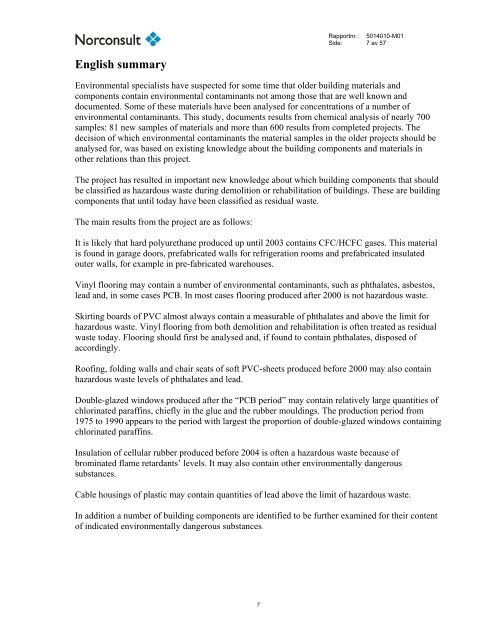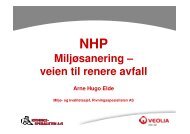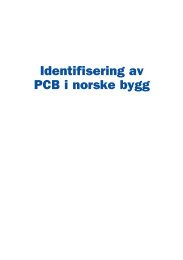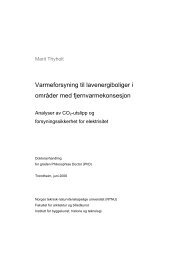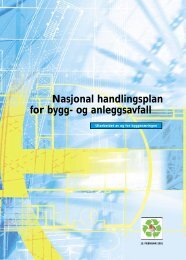Kartlegging av nyere fraksjoner av farlig avfall i bygg
Kartlegging av nyere fraksjoner av farlig avfall i bygg
Kartlegging av nyere fraksjoner av farlig avfall i bygg
Create successful ePaper yourself
Turn your PDF publications into a flip-book with our unique Google optimized e-Paper software.
English summary<br />
7<br />
Rapportnr.: 5014010-M01<br />
Side: 7 <strong>av</strong> 57<br />
Environmental specialists h<strong>av</strong>e suspected for some time that older building materials and<br />
components contain environmental contaminants not among those that are well known and<br />
documented. Some of these materials h<strong>av</strong>e been analysed for concentrations of a number of<br />
environmental contaminants. This study, documents results from chemical analysis of nearly 700<br />
samples: 81 new samples of materials and more than 600 results from completed projects. The<br />
decision of which environmental contaminants the material samples in the older projects should be<br />
analysed for, was based on existing knowledge about the building components and materials in<br />
other relations than this project.<br />
The project has resulted in important new knowledge about which building components that should<br />
be classified as hazardous waste during demolition or rehabilitation of buildings. These are building<br />
components that until today h<strong>av</strong>e been classified as residual waste.<br />
The main results from the project are as follows:<br />
It is likely that hard polyurethane produced up until 2003 contains CFC/HCFC gases. This material<br />
is found in garage doors, prefabricated walls for refrigeration rooms and prefabricated insulated<br />
outer walls, for example in pre-fabricated warehouses.<br />
Vinyl flooring may contain a number of environmental contaminants, such as phthalates, asbestos,<br />
lead and, in some cases PCB. In most cases flooring produced after 2000 is not hazardous waste.<br />
Skirting boards of PVC almost always contain a measurable of phthalates and above the limit for<br />
hazardous waste. Vinyl flooring from both demolition and rehabilitation is often treated as residual<br />
waste today. Flooring should first be analysed and, if found to contain phthalates, disposed of<br />
accordingly.<br />
Roofing, folding walls and chair seats of soft PVC-sheets produced before 2000 may also contain<br />
hazardous waste levels of phthalates and lead.<br />
Double-glazed windows produced after the “PCB period” may contain relatively large quantities of<br />
chlorinated paraffins, chiefly in the glue and the rubber mouldings. The production period from<br />
1975 to 1990 appears to the period with largest the proportion of double-glazed windows containing<br />
chlorinated paraffins.<br />
Insulation of cellular rubber produced before 2004 is often a hazardous waste because of<br />
brominated flame retardants’ levels. It may also contain other environmentally dangerous<br />
substances.<br />
Cable housings of plastic may contain quantities of lead above the limit of hazardous waste.<br />
In addition a number of building components are identified to be further examined for their content<br />
of indicated environmentally dangerous substances.


